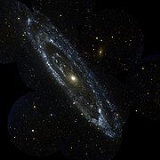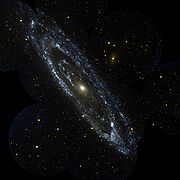
The Great Debate
Encyclopedia

Astronomy
Astronomy is a natural science that deals with the study of celestial objects and phenomena that originate outside the atmosphere of Earth...
, the Great Debate, also called the Shapley–Curtis Debate, was an influential debate
Debate
Debate or debating is a method of interactive and representational argument. Debate is a broader form of argument than logical argument, which only examines consistency from axiom, and factual argument, which only examines what is or isn't the case or rhetoric which is a technique of persuasion...
between the astronomers Harlow Shapley
Harlow Shapley
Harlow Shapley was an American astronomer.-Career:He was born on a farm in Nashville, Missouri, and dropped out of school with only the equivalent of a fifth-grade education...
and Heber Curtis which concerned the nature of spiral
Spiral galaxy
A spiral galaxy is a certain kind of galaxy originally described by Edwin Hubble in his 1936 work The Realm of the Nebulae and, as such, forms part of the Hubble sequence. Spiral galaxies consist of a flat, rotating disk containing stars, gas and dust, and a central concentration of stars known as...
nebula
Nebula
A nebula is an interstellar cloud of dust, hydrogen gas, helium gas and other ionized gases...
e and the size of the universe. The basic issue under debate was whether distant nebulae were relatively small and lay within our own galaxy
Galaxy
A galaxy is a massive, gravitationally bound system that consists of stars and stellar remnants, an interstellar medium of gas and dust, and an important but poorly understood component tentatively dubbed dark matter. The word galaxy is derived from the Greek galaxias , literally "milky", a...
or whether they were large, independent galaxies. The debate took place on 26 April 1920, in the Baird auditorium of the Smithsonian Museum of Natural History
National Museum of Natural History
The National Museum of Natural History is a natural history museum administered by the Smithsonian Institution, located on the National Mall in Washington, D.C., United States. Admission is free and the museum is open 364 days a year....
. The two scientists first presented independent technical papers about "The Scale of the Universe" during the day and then took part in a joint discussion that evening. Much of the lore of the Great Debate grew out of two papers published by Shapley and Curtis in the May 1921 issue of the Bulletin of the National Research Council
United States National Research Council
The National Research Council of the USA is the working arm of the United States National Academies, carrying out most of the studies done in their names.The National Academies include:* National Academy of Sciences...
. The published papers each included counter arguments to the position advocated by the other scientist at the 1920 meeting.
Shapley was arguing in favor of the Milky Way
Milky Way
The Milky Way is the galaxy that contains the Solar System. This name derives from its appearance as a dim un-resolved "milky" glowing band arching across the night sky...
as the entirety of the universe. He believed galaxies such as Andromeda
Andromeda Galaxy
The Andromeda Galaxy is a spiral galaxy approximately 2.5 million light-years from Earth in the constellation Andromeda. It is also known as Messier 31, M31, or NGC 224, and is often referred to as the Great Andromeda Nebula in older texts. Andromeda is the nearest spiral galaxy to the...
and the Spiral Nebulae were simply part of the Milky Way. He could back up this claim by citing relative sizes—if Andromeda was not part of the Milky Way, then its distance must have been on the order of 108 light years
Light Years
Light Years is the seventh studio album by Australian recording artist Kylie Minogue. It was released on 25 September 2000 by Parlophone and Mushroom Records. The album's style was indicative of her return to "mainstream pop dance tunes"....
—a span most astronomers
Astronomy
Astronomy is a natural science that deals with the study of celestial objects and phenomena that originate outside the atmosphere of Earth...
would not accept. Adriaan van Maanen
Adriaan Van Maanen
Adriaan van Maanen was a Dutch–American astronomer.Van Maanen, born into a well-to-do family in Friesland, studied astronomy at the University of Utrecht and worked briefly at the University of Groningen...
was also providing evidence to Shapley's argument. Van Maanen was a well-respected astronomer of the time who claimed he had observed the Pinwheel Galaxy
Pinwheel Galaxy
The Pinwheel Galaxy is a face-on spiral galaxy distanced 21 million light-years away in the constellation Ursa Major, first discovered by Pierre Méchain on March 27, 1781, and communicated to Charles Messier who verified its position for inclusion in the Messier Catalogue as one of its final...
rotating. If the Pinwheel Galaxy
Pinwheel Galaxy
The Pinwheel Galaxy is a face-on spiral galaxy distanced 21 million light-years away in the constellation Ursa Major, first discovered by Pierre Méchain on March 27, 1781, and communicated to Charles Messier who verified its position for inclusion in the Messier Catalogue as one of its final...
were in fact a distinct galaxy and could be observed to be rotating on a timescale of years, its orbital velocity would be enormous and there would clearly be a violation of the universal speed limit, the speed of light
Speed of light
The speed of light in vacuum, usually denoted by c, is a physical constant important in many areas of physics. Its value is 299,792,458 metres per second, a figure that is exact since the length of the metre is defined from this constant and the international standard for time...
. Also used to back up his claims was the observation of a nova
Nova
A nova is a cataclysmic nuclear explosion in a star caused by the accretion of hydrogen on to the surface of a white dwarf star, which ignites and starts nuclear fusion in a runaway manner...
in the Andromeda galaxy that had temporarily outshone the nucleus of the galaxy itself, a seemingly absurd amount of energy for a normal nova. Thus, the nova and the galaxy itself must be within our own galaxy since, if Andromeda were a galaxy in its own right, the nova would have had to have been unthinkably bright in order to be seen from so far away.
Curtis on the other side contended that Andromeda and other such nebulae were separate galaxies, or "Island universes" (a term invented by the philosopher Immanuel Kant
Immanuel Kant
Immanuel Kant was a German philosopher from Königsberg , researching, lecturing and writing on philosophy and anthropology at the end of the 18th Century Enlightenment....
, who also believed that the spiral nebulae were extragalactic.). He showed that there were more nova
Nova
A nova is a cataclysmic nuclear explosion in a star caused by the accretion of hydrogen on to the surface of a white dwarf star, which ignites and starts nuclear fusion in a runaway manner...
e in Andromeda than in the Milky Way. From this he could ask why there were more novae in one small section of the galaxy than the other sections of the galaxy, if Andromeda was not a separate galaxy but simply a nebula within our galaxy. This led to supporting Andromeda as a separate galaxy with its own signature age and rate of nova
Nova
A nova is a cataclysmic nuclear explosion in a star caused by the accretion of hydrogen on to the surface of a white dwarf star, which ignites and starts nuclear fusion in a runaway manner...
e occurrences. He also cited dark lanes present in other galaxies similar to the dust clouds found in our own galaxy and massive doppler shifts found in other galaxies.
Curtis stated that if van Maanen's observation of the Pinwheel Galaxy
Pinwheel Galaxy
The Pinwheel Galaxy is a face-on spiral galaxy distanced 21 million light-years away in the constellation Ursa Major, first discovered by Pierre Méchain on March 27, 1781, and communicated to Charles Messier who verified its position for inclusion in the Messier Catalogue as one of its final...
rotating were correct, he himself would have been wrong about the scale of the universe and that the Milky Way would fully encompass it.
After the debate
It later became apparent that van Maanen's observations were incorrect—one can not actually see the Pinwheel GalaxyPinwheel Galaxy
The Pinwheel Galaxy is a face-on spiral galaxy distanced 21 million light-years away in the constellation Ursa Major, first discovered by Pierre Méchain on March 27, 1781, and communicated to Charles Messier who verified its position for inclusion in the Messier Catalogue as one of its final...
rotate during a human lifespan
Life expectancy
Life expectancy is the expected number of years of life remaining at a given age. It is denoted by ex, which means the average number of subsequent years of life for someone now aged x, according to a particular mortality experience...
.
Due to the work of Edwin Hubble
Edwin Hubble
Edwin Powell Hubble was an American astronomer who profoundly changed the understanding of the universe by confirming the existence of galaxies other than the Milky Way - our own galaxy...
, it is now known that the Milky Way is only one of hundreds of billions of galaxies in the visible universe, proving Curtis the more accurate party in the debate in that respect. Also, it is now known that the nova Shapley referred to in his arguments was in fact a supernova
Supernova
A supernova is a stellar explosion that is more energetic than a nova. It is pronounced with the plural supernovae or supernovas. Supernovae are extremely luminous and cause a burst of radiation that often briefly outshines an entire galaxy, before fading from view over several weeks or months...
, which do indeed temporarily outshine the combined output of an entire galaxy. On other points the results were mixed (the actual size of the Milky Way is in between the sizes proposed by Shapley and Curtis), or in favor of Shapley (Curtis' galaxy was centered on the Sun, while Shapley correctly placed the Sun in the outer regions on the galaxy).
External links
- The Shapley–Curtis Debate in 1920—resources related to the debate at the NASANASAThe National Aeronautics and Space Administration is the agency of the United States government that is responsible for the nation's civilian space program and for aeronautics and aerospace research...
website

